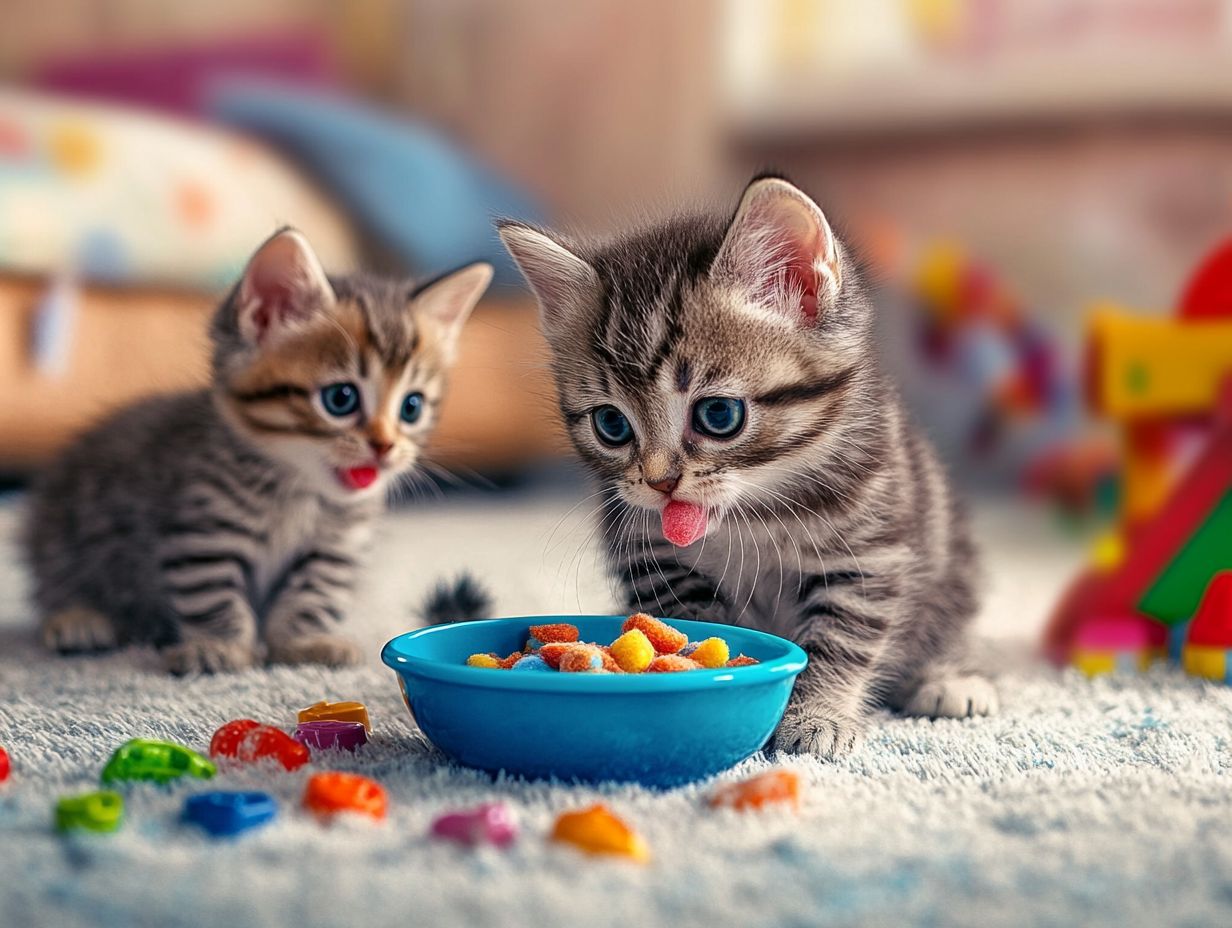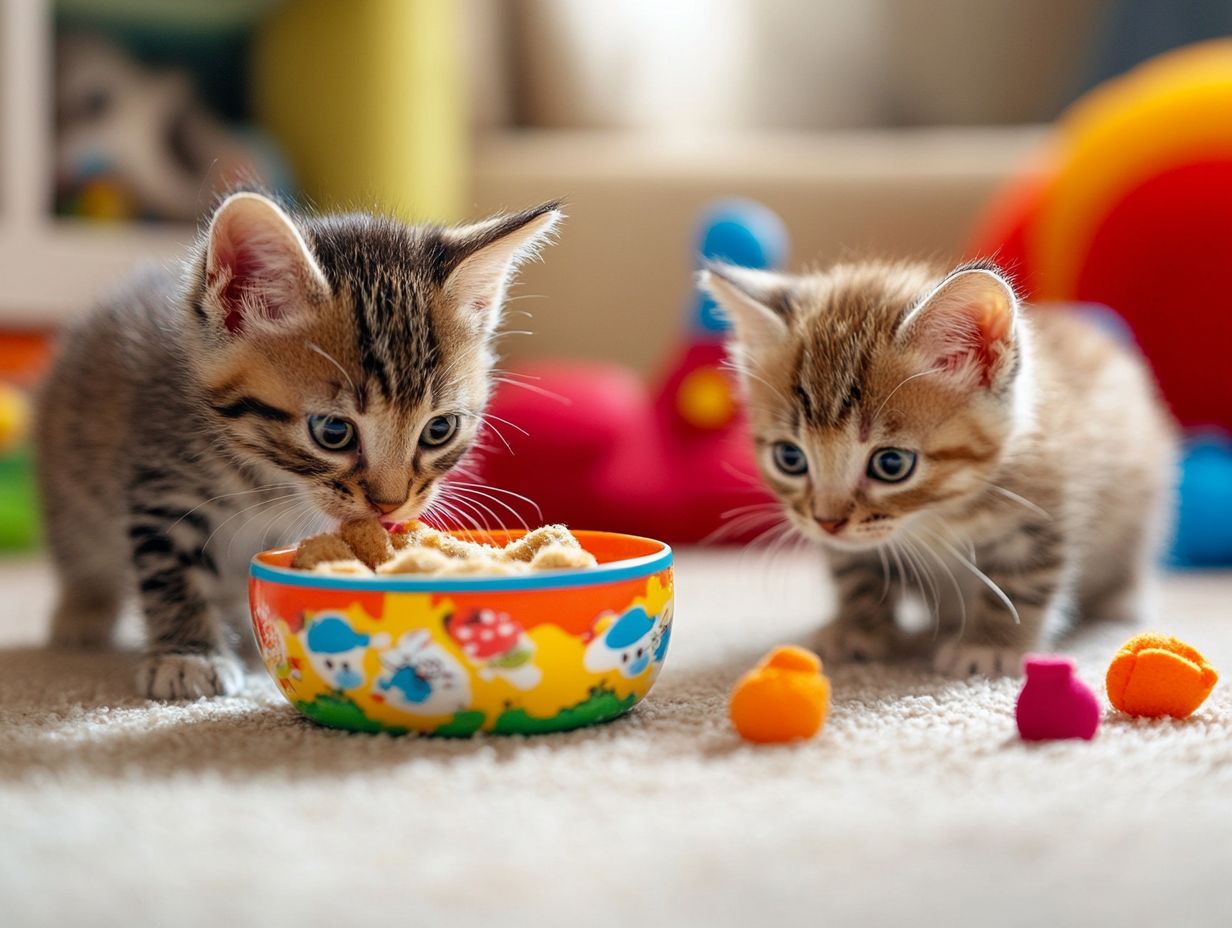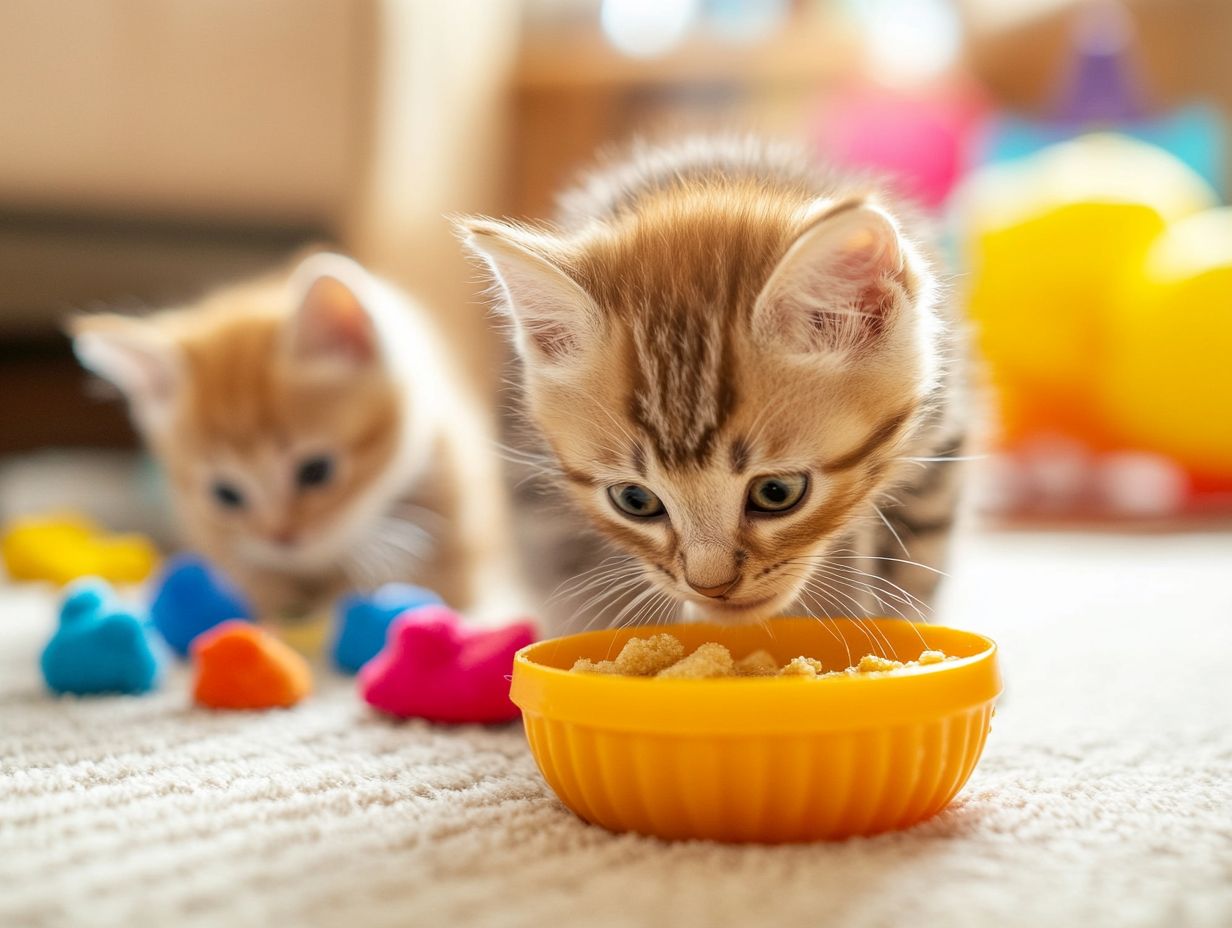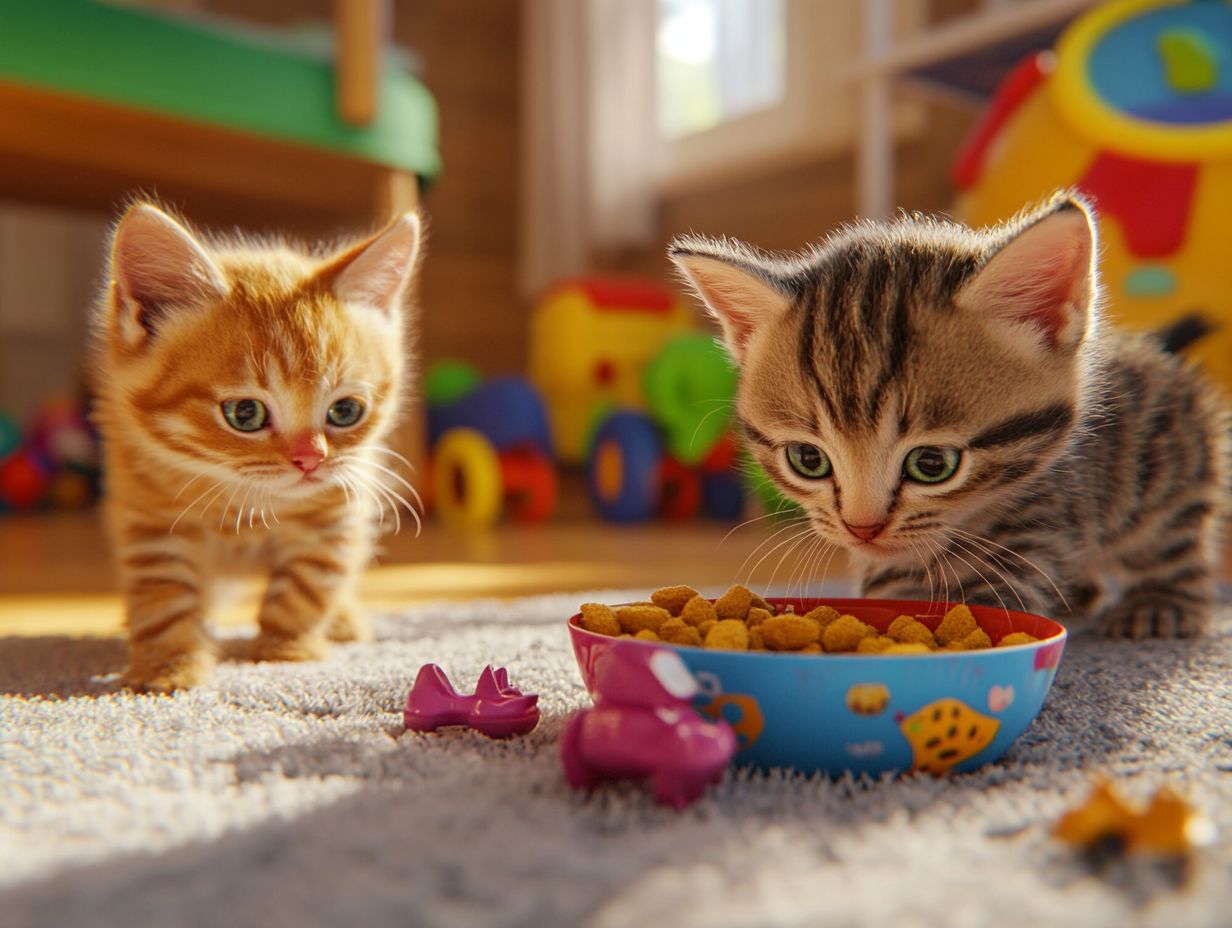Transitioning your kitten to solid food is an exciting milestone in their development, marking the end of nursing and bottle feeding. Following veterinary nutritional standards is crucial to ensure your kitten’s health during this transition. However, it can also be a bit daunting for new pet parents.
This week-by-week guide breaks down the feeding process, covering types of food to choose, the right quantities, and how to mix wet kitten food and dry food options for a balanced diet.
By following these clear steps, you can help your furry friend make a smooth transition, ensuring they receive proper nutrients while enjoying their meals. Always consult with a veterinarian before making significant changes to your kitten’s diet, especially for specific dietary needs or health conditions.
Read on to discover the best practices for feeding your growing kitten, including feeding tips and techniques!
Key Takeaways:

What Type of Food Should You Use?
When selecting food for your kitten, it’s essential to provide high-quality nutrition tailored to their unique needs. This includes incorporating both wet kitten food and dry food into their diet, ensuring a gradual transition from nursing.
Some high-quality kitten food brands that meet AAFCO standards include Royal Canin Kitten, Hill’s Science Diet Kitten, and Purina Pro Plan Kitten. Be sure to read the ingredients list carefully and ensure that the food emphasizes high-quality animal protein sources, as meaty foods are necessary for supporting healthy growth and development.
Wet kitten food offers essential moisture and is often more palatable, making it an excellent choice for hydration, especially for picky eaters. On the other hand, dry food can support dental health by helping to reduce tartar buildup. However, it should not be relied upon solely for oral hygiene; regular dental care should also be included in the kitten’s health routine. Additionally, the protein source is crucial, as meaty foods are necessary for supporting healthy growth and development.
When deciding between different formulas, be sure to read the ingredients list carefully and ensure that the food meets AAFCO standards, which guarantees it contains the nutrients required for your kitten’s overall health.
How Much Food Should You Give Your Kitten?
The amount of food given to a kitten should follow a standardized feeding schedule that is adjusted according to the kitten’s activity level and age, as this is crucial for their growth and development. Portions must be carefully monitored as they progress through different growth stages.
Younger kittens, specifically those aged six weeks to four months, require more calories per pound than older cats. A feeding chart can be useful in determining the appropriate amount of food for a kitten based on their age and weight.
For instance, an eight-week-old kitten may need approximately ¼ to ½ cup of wet food per day, while a four-to-six-month-old kitten may require ½ to ¾ cup. These amounts should be adjusted regularly as the kittens grow to ensure that their high-calorie needs are met. It’s important to monitor your kitten’s weight and health during this process and follow up with a veterinarian for tailored advice based on your kitten’s specific growth patterns.
How Often Should You Feed Your Kitten?
Kittens should be fed on a consistent schedule, with many veterinarians recommending multiple feedings throughout the day to maintain their energy levels and keep them hydrated.
Establishing a feeding routine that reflects their natural behaviors allows caregivers to mimic their instinctive habits, such as hunting and consuming smaller portions. Ideally, kittens should be fed at intervals of four to six hours, aligning with their feeding preferences and behavioral patterns.
It is also important to provide fresh water along with solid food, as proper hydration is essential for overall health and digestion. Additionally, adjusting the feeding schedule based on the kitten’s responses can help ensure healthy growth and development, fostering a positive long-term relationship with food.
Special considerations must be taken for different life stages: kittens, pregnant or nursing cats, and senior cats all have unique nutritional needs that should be addressed in their feeding routines.
Week 2: Increasing the Amount of Solid Food
In Week 2, you should gradually increase your kitten’s consumption of solid food, aligning it with their increased appetite and ongoing growth as they continue the weaning process from nursing and bottle feeding. For more guidance, check out this week-by-week guide on transitioning kittens to solid food.
How Much Should You Increase the Amount of Food?
Gradually increasing the portion of food for a kitten is essential, as it helps their appetite grow while providing the necessary high calories to meet their energy requirements. A feeding chart can assist owners during this transition.
Be cautious of potential allergens and toxic ingredients in kitten food, such as garlic, onion, and certain artificial additives. It’s essential to avoid these to ensure your kitten’s safety.
Lastly, be wary of the potential risks of homemade or raw diets; always urge consultation with a veterinarian before making such choices, especially to address any specific dietary requirements.
For weight management, refer to the latest guidelines from AAFCO, WSAVA, or other authoritative bodies on feline obesity and the importance of maintaining a healthy weight.
When it comes to storage and handling, ensure best practices for storing both wet and dry kitten food to prevent spoilage, contamination, or toxin development.
By incrementally increasing the food amount each week, pet owners can better accommodate their growing kitten’s needs. It is important to start with small adjustments—perhaps one-quarter of the new recommended amount at a time—so their digestive system can adapt.
During this period, owners should weigh their kittens regularly to ensure they are growing at an appropriate rate and to prevent overfeeding, which can lead to lifelong health issues such as obesity. For guidelines on feeding amounts, consult a veterinarian or refer to the AAFCO guidelines.
What Are Some Signs That Your Kitten is Ready for More Solid Food?

Signs that your kitten is ready for solid food include noticeable behavioral changes, such as an increased interest in the food dish and exploratory behavior around solid food options. These signs indicate that your pet is becoming more independent, suggesting it is time to diversify their diet and continue the weaning process from nursing.
The first indicator that your kitten is ready for solid food is their heightened interest in the food dish at mealtime. Kittens often display curiosity by approaching their food dish, sniffing it, or even attempting to nibble on your food when they see you eating.
The second sign is the exploratory behavior they exhibit around food dishes. Kittens may paw at, inspect, or even taste the various solid food options you provide. This curiosity indicates their readiness to experiment with new textures and flavors.
It is important to monitor your kitten’s behavior and adjust their diet accordingly by gradually introducing wet or dry kitten food. This introduction to water and solid food should start with a combination of both, allowing your kitten to transition more smoothly. Be sure to monitor their reactions and adjust portion sizes as needed.
Week 3: Mixing Wet and Dry Food
In Week 3, begin introducing a combination of wet and dry food to your kitten. This mix not only meets their nutritional needs but also exposes them to various textures and flavors.
Why is it Important to Mix Wet and Dry Food?
Combining wet and dry food is essential for ensuring that your kitten receives a balanced diet that meets their nutritional needs while also keeping them well-hydrated. Wet food generally contains a higher moisture content, which is crucial for maintaining hydration, particularly since kittens can be prone to urinary tract issues when their water intake is insufficient.
On the other hand, dry food offers a crunchy texture that supports dental health by reducing plaque and strengthening teeth. By mixing both types of food, you can cater to a variety of taste preferences and promote a more holistic approach to nutrition. For more information on how to transition kittens to solid food, check out this Week-by-Week Guide.
This balanced feeding strategy may also enhance overall eating habits, encouraging kittens to explore a wider range of flavors and textures. However, be cautious of potential nutritional deficiencies that could arise from not providing a balanced diet during the transition phase.
How Much Wet Food Should You Mix With the Dry Food?
Understanding how much wet food to mix with dry food for kittens is essential for maintaining appropriate nutritional ratios and encouraging their appetite. Pet owners can use a feeding chart to determine the right proportions for optimal mixing.
A common recommendation is a ratio of two parts dry food to one part wet food; however, it is important to consider each kitten’s individual needs based on factors such as size, age, and activity level. For kittens with specific health concerns, such as diabetes or allergies, consulting a veterinarian for tailored advice is recommended.
Establishing a consistent feeding schedule not only regulates their eating habits but also benefits their digestive system. Regular mealtimes provide a sense of security for your pet, ensuring their mental and physical well-being while fostering a positive association with eating.
Week 4: Gradually Reducing Wet Food
During Week 4, the amount of wet food is gradually reduced as the kitten begins to eat more solid food, facilitating a smoother transition to a fully solid diet.
How Much Wet Food Should You Give Your Kitten?
Determining the appropriate amount of wet food to give your kitten during this stage is essential to ensure they receive the right nutrients as they transition to a solid food diet. All changes to their meals should consider factors such as age, weight, and activity level. Always consult with a veterinarian when implementing dietary changes to ensure they align with your kitten’s health needs.
Food Storage and Handling
Proper food storage and handling practices are crucial to prevent spoilage and ensure food safety. Store wet food in a cool, dry place, and once opened, keep it refrigerated and use it within a few days. Always check for signs of spoilage, such as an off smell or unusual texture, before feeding your kitten.
Using a feeding chart can be a helpful tool, as it provides recommendations on how much wet food to offer your kitten based on these criteria. A kitten should consume a combination of both wet and dry food, with wet food comprising 30-50% of their total food intake, as supported by veterinary nutrition guidelines from AAFCO and WSAVA.
This approach not only supports their nutritional needs but also helps keep them hydrated, as kittens are more susceptible to dehydration. Regularly monitoring their water intake, in addition to their wet food servings, can help ensure they remain healthy and energetic. Remember, as obligate carnivores, cats require specific nutrients found in animal-source proteins.
What are Some Signs That Your Kitten is Ready for Only Solid Food?

Recognizing the signs that a kitten is ready to transition to a diet of only solid food is crucial, as these indicators suggest that the kitten is becoming more independent and can adapt to new feeding schedules.
The signs include:
- Increased curiosity about food
- A tendency to chew rather than suck
- The ability to eat solid food without gagging
Establishing feeding schedules can facilitate the transition to solid food by helping kittens adjust and providing them with a sense of security. However, some kittens may display behavioral issues, such as refusing to eat solid food or exhibiting overly aggressive eating habits. If refusal persists, it is important to discuss these issues with a veterinarian to rule out any underlying health conditions. For more information on this process, check out the Transitioning Kittens to Solid Food: A Week-by-Week Guide.
Addressing these issues early is essential to ensure that the feeding process remains a positive experience, promoting the development of healthy eating habits.
Week 5: Transitioning to Only Solid Food
In Week 5, the primary focus is on transitioning the kitten to a diet of solid food only. This process requires extra attention to feeding instructions and the provision of high-quality food options from reputable brands that meet AAFCO standards, ensuring they meet the kitten’s dietary requirements.
How Much Solid Food Should You Give Your Kitten?
Determining the correct quantity of solid food for a kitten is essential to ensure they receive the right amount of nutrients and maintain a consistent feeding schedule. Pet owners should consult a solid food feeding chart sourced from a reputable veterinary or pet nutrition authority that outlines recommended portion sizes based on the kitten’s age and weight.
For instance, younger kittens tend to require smaller, more frequent meals, while older kittens can be fed larger portions but less often. It’s important to regularly monitor the kitten’s weight and adjust portions accordingly with a veterinarian’s guidance, as overfeeding can lead to obesity and related health issues.
Establishing a regular feeding schedule not only promotes healthy eating habits but also provides the kitten with a sense of security. Kittens should not be fed exclusively dry food; incorporating wet food into their diet is crucial for balanced nutrition.
What Should You Do If Your Kitten Refuses to Eat Solid Food?
If your kitten refuses to eat solid food, it is essential to implement the right feeding tips and techniques to help them acclimate to this new diet. Understanding the underlying reasons for this aversion is important, as kittens may avoid solid food due to teething, a preference for a specific texture, or even underlying medical conditions that require attention. If the refusal persists, consulting a veterinarian is advisable, as it could indicate dental issues or other health concerns.
Mixing a small amount of wet food with the solid food can create a more appealing consistency, and serving the food at room temperature may enhance its attractiveness. Additionally, providing a calm and friendly feeding environment can help reduce any anxious behaviors that might prevent them from eating.
Introducing solid foods slowly in a playful manner or using interactive feeding toys can make the experience more enjoyable and encourage them to try the new food.
Week 6: Monitoring Your Kitten’s Diet and Health
In Week 6, it is important to closely monitor your kitten’s diet and health to ensure that the transition to solid food has been successful. Additionally, make sure they are receiving regular meals that meet their ongoing nutritional needs.
How Often Should You Feed Your Kitten?
Feeding your kitten at appropriate intervals is essential for maintaining their energy levels and ensuring proper hydration, making adherence to a feeding schedule crucial. Kittens should have access to fresh water at all times.
A 6-week-old kitten should be fed every three to four hours during the initial weeks of rapid growth and development. Frequent meals during this period will assist in their transition to solid food and allow for easier monitoring of their health and weight gain.
Additionally, proper food storage and handling practices are essential to prevent spoilage, ensuring food safety for your kitten.
As they adjust, it is important for owners to closely monitor their weight gain and energy levels to ensure they are thriving on solid food. Once solid food becomes the mainstay of their diet, owners can gradually reduce the frequency of feedings, but it should remain at a level that meets their ongoing nutritional needs. It is recommended to consult with a veterinarian before making any dietary changes, especially for kittens with existing health concerns.
What Should You Do If Your Kitten Experiences Digestive Issues?

The first step in diagnosing a kitten’s digestive issues is to evaluate their dietary changes and assess the feeding schedule to identify any contributing factors to their health problems. Sudden changes in diet can lead to gastrointestinal upset; therefore, introducing new foods slowly over several days is crucial. Observing the kitten’s eating habits may reveal that they are overeating or consuming their food too quickly.
It is crucial to ensure they have access to clean, fresh water at all times, as dehydration can exacerbate digestive discomfort. Additionally, the kitten’s medical history should be considered, including any previous dietary sensitivities or gastrointestinal issues, as these may offer insights into the current problem. Also, ensure that any new food meets AAFCO standards for kitten nutrition, including proper protein levels and essential nutrients.
It is important to cater to their food preferences (such as wet versus dry food and flavor profiles) while providing the appropriate portions. When selecting kitten food, look for foods labeled ‘complete’ and ‘balanced’ by AAFCO to ensure clarity and accuracy. Offering smaller, more frequent meals is generally better for aiding digestion and promoting overall health than serving larger portions. Additionally, monitoring water intake, especially during the transition to solid food, is vital to prevent dehydration and support digestive health.
Frequently Asked Questions
What is the best age to start transitioning kittens to solid food?
The best age to start transitioning kittens to solid food is around 4-5 weeks old. At this age, they are able to start exploring and trying new foods. Starting the transition too early or too late may pose risks, as it is essential to align the process with the developmental readiness of the kittens.
How much solid food should I give my kitten during the first week of transitioning?
During the first week of transitioning, you should offer about ¼ cup of wet food per day, divided into 3-4 meals. This will help your kitten adjust to the new type of food.
What type of food is best for transitioning kittens?
Wet food is recommended for transitioning kittens as it is easier for them to chew and digest compared to dry food. Look for foods labeled ‘complete’ and ‘balanced’ by AAFCO, with a protein source as the first ingredient, to ensure appropriate nutrition.
Can I mix wet and dry food when transitioning my kittens?
Yes, you can mix wet and dry food during the transitioning process. Gradually increase the amount of dry food and decrease the wet food until your kitten is fully transitioned to dry food.
What if my kitten is not interested in the solid food during the first week?
If your kitten is not interested in the solid food during the first week, do not force them to eat it. Offer a small amount of wet food and try again the next day. It may take some time for them to get used to the new food.
How do I know when my kitten is fully transitioned to solid food?
You will know your kitten is fully transitioned to solid food when they are eating the recommended amount for their age and weight, and they have a healthy appetite. It may take a few weeks for the transition to be complete.
Note: Always ensure safe food storage and handling practices to prevent spoilage. Recognize signs of food spoilage that could affect your kitten’s health, such as off smells, changes in texture, or discoloration.